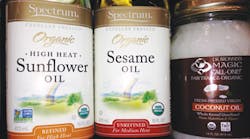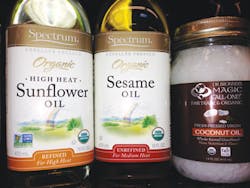Author Comment: A recent segment on "The Dr. Oz Show" contained information on oral oil pulling and provided a demonstration of this procedure. This daily television show provides health information and disease prevention segments to its viewers. Since oil pulling is not familiar to the dental community, it warrants discussion and information that the dental professional should be aware of when treating patients who may use this practice. Dr. Oz has presented other dental advice to viewers in the past and the program has a large number of followers. This column is not intended to promote oil pulling without high evidenced-based information, but it is meant to provide information on the subject since the reality of treating patients who use this practice is very possible.
Your patient today is a lovely woman from Southern India named Amisha. She is new to your practice and has just been transferred to the United States with her two children due to her husband's position at a local company. Amisha is 32 years old, in excellent health, and has no dental problems that she reports.
During your oral assessment you inquire about her oral hygiene practices. Amisha tells you that she has used oral oil pulling and swishing followed by brushing and flossing as part of her daily routine. This has been her practice since she was a teenager. Growing up in her community in southern India, this was a common practice that was taught to older children. You ask her to tell you more about this practice since you are not familiar with the use of oil swished orally.
-----------------------------------------------------------------
Other articles by Burkhart
- Oral Exam: Mesiodens
- Taste distortions in dental patients
- Dental Oral Exam case study: Pernicious Anemia
-----------------------------------------------------------------
Ayurvedic medicine evolved 3,000 to 5,000 years ago and is one of the world's oldest whole body healing systems. The concept is based on the connection of the body with mind and spirit. All three must be in harmony to promote health. The best analogy is that of a tree that is diseased. The roots are nourished so that the tree becomes strong, and able to fight off stress and disease. Oil pulling or oil swishing has been commonly practiced within Ayurvedic medicine communities in India for centuries.
Typically, quality oil is used, such as sesame or sunflower oil, and the oil is pulled throughout the mouth and teeth contacting the oral tissues for approximately 10 minutes (some suggestions are for up to 20 minutes). The liquid is not swallowed but is expectorated. The teeth are brushed and flossed following the swish (see related short article for protocols) and some recommend a saltwater rinse as well.
Sesame oil (Sesamum indicum plant) is a monounsaturated fat and belongs to a family of others rich in these types of fats such as avocados, peanuts, and almonds. These types of fats, when eaten, are part of a healthy diet and should replace the unhealthy fats that are consumed by many individuals. A balance of calories must be considered as well. Sesame oil is high in nutritional benefits with antioxidants of mainly three lignans: sesamol, sesamin, and sesamolin that have antioxidant properties and potentiate vitamin E. Vitamin E is protective against heart disease and strokes (Asokan, 2008).
Since sesame oil is used in cooking within Indian households, the oil has always been readily available and has been the oil of choice. Lignans are a group of chemical compounds found in plants and they are one of the major classes of phytoestrogens. Their chemical action is that of an antioxidant. Ayurvedic medicine and Indian folk remedy utilizes the oil pulling to prevent caries, oral malodor, bleeding gums, cracked lips, sore throat issues, as well as strengthening the teeth.
Asokan suggests that, although the mechanism of the process of oil pulling is not exact, it is believed that the oil, which is a vegetable oil, is acted on by the salivary alkali and a "soap making process" known as saponification is initiated. Saponification is defined as a chemical reaction in which an ester is heated with an alkali. An example is the alkaline hydrolysis of a fat or oil to make soap. Emulsification is initiated in which the oil is broken down into minute droplets and the surface area of the oil is increased. It is believed that the "unsaponifiable" components of the sesame oil, sesamin, or sesamolin offer protection to the oral cavity because of the antioxidant properties.
Chlorhexidine mouthwash is often used to control gingivitis in clinical practice. A study by Asokan et al. evaluated the use of chlorhexidine and oil pulling therapy in the treatment of gingivitis. The study was a randomized, controlled, triple-blind study (2009). The study evaluated oil pulling on plaque-induced gingivitis. The effect of chlorhexidine used in the management of gingivitis is known. But in the Asokan study, oil pulling was found to be equally effective in controlling gingivitis. The advantages of oil pulling over chlorhexidine were the following:
- No staining
- No lingering aftertaste
- No allergies to the product
- Cost savings was five to six times more cost effective.
The study found that there was a statistical significance of P<0.05 in both groups with regard to a reduction in the modified gingival index scores and a reduction in the plaque index score. A larger reduction in total colony count of microorganisms was found within the oil pulling group, but not at a significant level. The author concluded that oil-pulling therapy promises to be a better preventive home therapy in developing countries such as India where cost and accessibility are an issue. The sample size of the study was very small and the ethnicity of the population was Indian with specific dietary practices, so the results are difficult to generalize to larger populations. And the evidenced-based significance is low. A more recent research study (Asokan et al. 2011) on Streptococcus mutans counts in plaque and saliva, a randomized controlled trial, also found chlorhexidine and oil pulling equally effective in reduction of S. mutans in a patient population. Further research is suggested with larger, varied populations.
The practice of oil pulling has been utilized in locations such as India and especially southern India for centuries. Sesame oil has been used because of its known nutritional qualities when ingested and this practice of using it orally has been taught and passed down through generations.
The evidenced-based data at this point is very limited and not at a confident level. Since the practice of oil pulling is promoted as reducing pathogens and elevating oral health, one would expect that those who do use oil pulling frequently would have less oral disease including periodontal disease. The prime author of the currently published studies suggests that oil pulling cannot be recommended as a treatment adjunct as of now, but it can be used as a preventive home therapy to maintain oral hygiene.
Oil pulling is an interesting concept, without any stated negative effects. Since the world has become so widely dispersed in ethnicity, the likelihood of encountering a patient who practices oil pulling is very possible, and dental professionals should be knowledgeable regarding practices that have been used for centuries in other cultures. These practices should be taken into consideration when suggesting home care and any treatments such as oral medications. The combination of the oil with other oral medications has not been studied.
Since the segment appeared on the Dr. Oz television series, more individuals who adhere to advice given in this series may be practicing this procedure. In one publication newsletter by Dr. Andrew Weil, a bottom line comment was: "Oil pulling won't hurt you, but I wouldn't depend on it to help you improve your overall health or treat significant medical problems."
Keep asking good questions and always listen to your patients.
Oil Pulling Therapy Protocol
- Purchase a quality, cold pressed oil. Sesame oil is highly recommended because the plant is known for its nutritional value. Instead of sesame oil, some individuals also use sunflower oil, red palm oil, and coconut oil. Dark bottle containers are recommended to ensure stability.
- For adults, one to two tablespoons are sipped, held in the mouth, and swished for approximately 10 to 20 minutes. In Ayurvedic medicine, children over 10 years old would use the oil in a quantity of one teaspoon.
- The oil is swished throughout the mouth and pulled through the teeth and oral structures. The liquid is never swal lowed.
- The liquid becomes watery and white as it is mixed with saliva, debris, oral bacteria, etc.
- The individual then expectorates into a cup or tissue and the mixture is discarded into a trash receptacle. Expectorating into a bathroom sink may eventually cause clogging of the pipes.
- Oil pulling should be followed by vigorously rinsing the mouth. Thoroughly brushing the teeth and flossing is also extremely important to remove any existing residue and debris. Some authors recommend rinsing with warm saltwater after expectorating and before brushing.
- Using a tongue cleaner after brushing the tongue removes lingering residue left in the papillae from the oil pulling.
- The protocol is recommended for first thing in the morning on an empty stomach.
- Gargling with the liquid is also practiced, without swallowing any liquid; this is also practiced for dryness of the throat area.
NANCY W. BURKHART, BSDH, EdD, is an adjunct associate professor in the department of periodontics, Baylor College of Dentistry and the Texas A & M Health Science Center, Dallas. Dr. Burkhart is founder and cohost of the International Oral Lichen Planus Support Group (http://bcdwp.web.tamhsc.edu/iolpdallas/) and coauthor of General and Oral Pathology for the Dental Hygienist. She was a 2006 Crest/ADHA award winner. She is a 2012 Mentor of Distinction through Philips Oral Healthcare and PennWell Corp. Her website for seminars on mucosal diseases, oral cancer, and oral pathology topics is www.nancywburkhart.com.
References
Asokan S, Rathinasamy TK, Inbamani N, Menon T, Kumar S, Emmadi P, Raghuraman R. Mechanism of oil-pulling therapy – In vitro study. Indian J Dent Res 2011; 22(1): 34-37.
Asokan S, Emmadi P, Chamundeswari R. Effect of oil pulling on plaque induced gingivitis: a randomized, controlled, triple-blind study. Indian j Dent Res 2009; 21(1): 47-51.
Asokan S, Jeevarathan J, Shakeer A, Emmadi P, Raghuraman R. Oil pulling therapy on streptococcus mutans count in plaque and saliva – a randomized controlled trial. J Indian Assoc of Public Health Dentistry Vol:2011;18 Suppl. lll. 948-52.
Abhinav S, Purohit B. Tooth brushing, oil pulling and tissue regeneration: A review of holistic approaches to oral health. J Ayurveda Integr Med. 2011 Apr-Jun; 2(2): 64-68.
Asokan S, Kumar RS, Emmadi P, Raghuraman R, Sivakumar N. Effect of oil pulling on halitosis and microorganisms causing halitosis: A randomized controlled pilot trial. J Indian Soc Pedod Prev Dent [serial online] 2011 [cited 2014 Feb 17];29:90-4. Available from: http://www.jisppd.com/text.asp?2011/29/2/90/84678
Dr. Bruce Fife Interview: http://www.coconutresearchcenter.org/article%20oil%20pulling.htm
Fife B. Oil Pulling Therapy. www.pickadillybooks.com
Oil pulling demonstration video: http://www.oilpulling.com/oilpullingvideos.htm
Dr. Andrew Weil Newsletter: http://www.drweil.com/drw/u/QAA400499/Oil-Pulling-Realistic-Remedy.html








